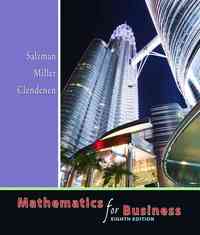Question
Intermediate Corporate Finance - Fin 304 Ballpark Inc. Part I. Cash Flow Estimation and Capital Budgeting Criteria The Ballpark Company is evaluating the market potential
Intermediate Corporate Finance - Fin 304
Ballpark Inc.
Part I. Cash Flow Estimation and Capital Budgeting Criteria
The Ballpark Company is evaluating the market potential of brightly colored bowling balls. The results of an initial questionnaire that Ballpark has conducted in major markets six months ago and cost $50,000 were positive. A more comprehensive market test study that will cost an additional $250,000 was just completed and affirmed at least a 15% of the total bowling ball market. Ballpark has not yet paid for this study.
Now Ballpark is at the point where it is considering investing in the assets needed to produce the colored balls. The balls would be produced in a building owned by the firm. The building, which was bought by Ballpark 20 years ago for $60,000, is currently vacant but it can be sold for $160,000. The value of the building on Ballpark's books is $32,000. Ballpark can depreciate this $32,000 over four years on a straight-line basis. In order to estimate the market value of the building at project's end, the company assumes that the price change will follow the trend experienced in the last 20 years. The land on which the building sits was bought for $51,000 twenty years ago and it is valued at $136,000 today. The expected appreciation in the land value is 4% per year over the coming ten-year period. Ballpark assumes that it will be able to sell both the building and the land together at their expected values at the end of the project's life.
The price of the new equipment needed is $912,000. It will require and additional $48,000 in shipping and installation costs. The useful life of the machine is 15 years but the company intends to use it for only the ten years that is the life of the project and then sell it at the termination of the project. It estimates its salvage value at $512,000. Production is estimated to be 37,500 units in the first year, rising by 17% per year for the following five years then falling by 7% per year for the remaining life of the project. The price of the balls in the first year will be $28. The bowling ball market is highly competitive and Ballpark believes that the price will increase by 3.5% per year. However, the plastic used to produce bowling balls is rapidly becoming more expensive. Variable production costs that will be $11 per unit in the first year will rise by 14% per year for the next four years then by 8% per year for the following five years. Total fixed costs excluding depreciation expense is assumed to stay constant at $480,000 per year for the life of the project. In addition, Ballpark is aware of the fact that some of the demand for its colored balls will be the result of shifting demand from its sales of the old black balls. It estimates that the new production will replace 3,200 units per year that bring in an after-tax EBIT of $13 per unit. The marginal tax rate applicable to this project is 25%.
Ballpark anticipates that it will maintain an investment in working capital equal to $48,000 initially (at time point zero) and rising by 4% per year in the first seven years then declining by 16% in each of years eight and nine before is completely retrieved in year ten.
Ballpark uses the straight line depreciation for all its depreciable assets.
I)On an Excel spreadsheet, estimate the following:
1.Initial net investment (NINV) (show it clearly in one box)
2.Total after-tax salvage value (ATSV) for all assets (clearly show details for each salvageable asset in another box)
3.The annual depreciation schedule
4.The annual incremental investment in NWC
5.Annual free cash flows (FCF)
At this point in the project, assume that the required rate of return on Ballpark's project of similar risk is 15%.
II)Use the capital budgeting decision criteria to decide which ones point to acceptance of the new project. Show in as much detail as possible on an Excel spreadsheet how you will evaluate the project including all estimates of cash flows and all the necessary calculations. Assume Ballpark uses a required payback of 6 years or less.
III)Ballpark is not always comfortable with the estimate of its cost of capital so it uses a sensitivity analysis to check how robust its project valuations to various estimates of cost of capital. The estimate should start with 0% and increase by increments of 5% points until it reaches 30%. For each estimate an NPV is calculated to analyze the sensitivity of NPV to various discount rate assumptions. Plot the NPV profile (NPV on y-axis and discount rates on x-axis). Watch where the NPV curve intersects with the x-axis. What do you call the intersection point?
Spreadsheet is due as an Excel file (email it and keep the file) by Tuesday, October 29th 2019.
(Hint: use Excel's "round" function to round the number of units to zero decimals, price per unit and variable cost per unit to two decimals).
Step by Step Solution
There are 3 Steps involved in it
Step: 1

Get Instant Access to Expert-Tailored Solutions
See step-by-step solutions with expert insights and AI powered tools for academic success
Step: 2

Step: 3

Ace Your Homework with AI
Get the answers you need in no time with our AI-driven, step-by-step assistance
Get Started


